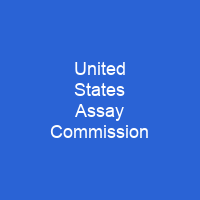The United States Assay Commission: A Legacy of Coin Quality Control
Imagine a time when every coin minted by the United States was put through rigorous testing to ensure its purity and weight—this is exactly what the United States Assay Commission did from 1792 until 1980. This commission, made up of prominent Americans including numismatists, played a crucial role in maintaining the integrity of our nation’s currency.
The Formation and Early Years
Formed by the Mint Act of 1792, the United States Assay Commission was tasked with overseeing the testing of gold, silver, and base metal coins produced by the US Mint. The commission’s first meeting took place in March 1797, marking the beginning of a long-standing tradition that would span nearly two centuries.
Challenges and Adaptations
Throughout its history, the commission faced numerous challenges. For instance, in 1801, there was a delay due to poor weather conditions, while disease outbreaks caused delays in 1806 and 1815 sessions. A snowstorm in 1812 further disrupted proceedings. In 1817, the commission’s activities were halted after a fire damaged the Philadelphia Mint.
Evolution of the Commission
The Mint Act of 1837 established an annual trial session on February 2nd and allowed public members to join, though this reduced their permanency and official status. The commission’s role expanded with the introduction of new coinage laws in 1864 and 1873, which required specific coins to be set aside for assay.
Notable Findings
In 1881, the commission discovered that some silver dollars struck at the Carson City Mint were underweight due to incorrect metal composition. In 1921, it was found that coins from the Denver Mint had excessive silver content—a stark reminder of the meticulous nature of their work.
Storage and Procedures
The pyx, a rosewood box used for storing assay coins, initially held about 750 coins but grew to over 79,000 by 1940. By the late 1940s, storage capacity became insufficient due to high production levels. The commission’s procedures evolved significantly, with more rigorous testing methods and increased public involvement.
Final Years and Abolition
In the 1950s, the process for selecting an Assay Commissioner was changed to include more nominations and screenings. By 1978, hundreds of numismatists applied to join the commission, but it faced criticism as unnecessary due to internal Mint checks. In 1980, legislation abolished the commission, citing diminished need due to the end of gold and silver coinage.
Medals and Commemoratives
The commission’s members received commemorative medals, which were rare except for the 1977 issue sold to the public. These medals, struck in various metals starting from 1860, became a tradition among assay commissioners. The Old Time Assay Commissioners Society (OTACS) formed in 1964 and met annually until its dissolution in 2012.
Conclusion
The United States Assay Commission, with its rich history and dedicated members, played a vital role in ensuring the quality of our nation’s currency. From its formation to its abolition, this commission stood as a testament to the importance of integrity and precision in monetary affairs.

You want to know more about United States Assay Commission?
This page is based on the article United States Assay Commission published in Wikipedia (retrieved on November 30, 2024) and was automatically summarized using artificial intelligence.







